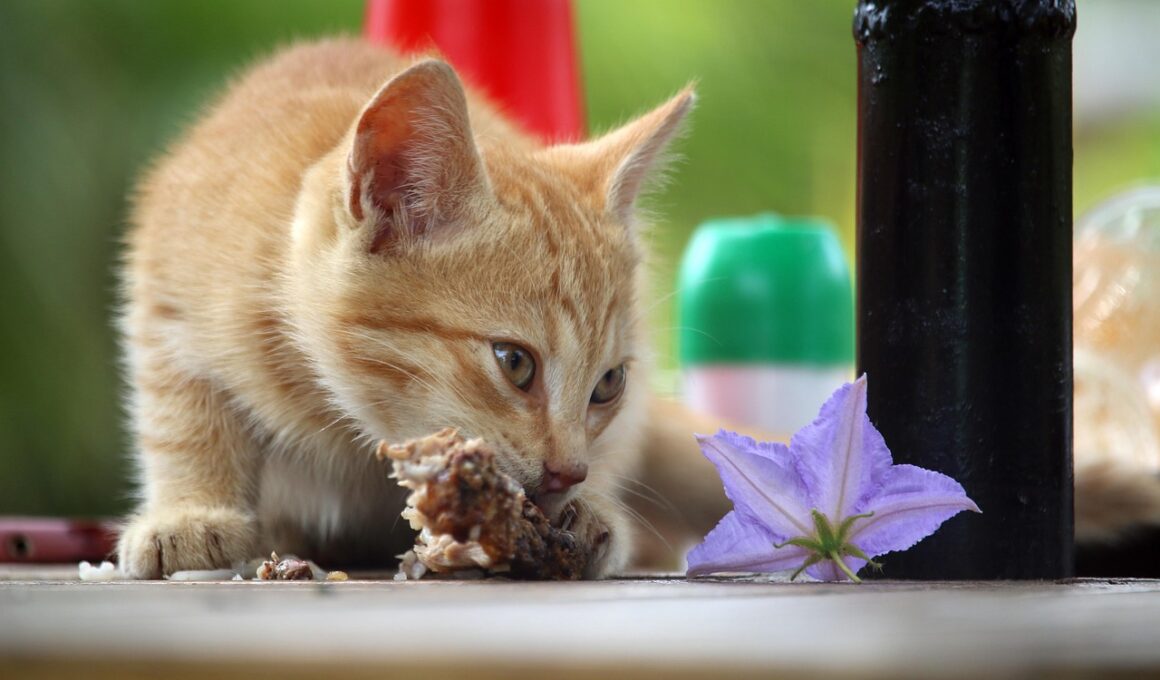The Role of Feeding Stations in Enrichment Programs
Feeding stations are an essential component of environmental enrichment programs for cats, significantly enhancing their overall well-being. These stations can provide an engaging way for cats to access food, mimic natural hunting behaviors, and stimulate their curiosity. Feeding stations can vary widely, from simple bowls to intricate devices that encourage exploration and interaction. The placement, design, and functionality of these stations greatly affect their success. Ideally, the stations should be positioned in various environments to stimulate exploratory behavior, allowing cats to discover different feeding options throughout their habitat. When well-implemented, feeding stations can foster physical activity, cognitive skills, and social interactions among cats. This enjoyment transforms meal times into more than just nourishment, creating a dynamic and enriching experience. By providing varied access to food, these stations help manage weight and encourage healthy eating habits. To maximize these benefits, owners should consider incorporating various sizes, shapes, and textures. Regularly changing feeding locations or introducing new stations can further retain interest and engagement while minimizing boredom. Thus, feeding stations play a significant role in promoting the mental and physical health of domesticated cats.
Feeding stations can play a significant role in enriching a cat’s environment. These stations are specifically designed to encourage natural behaviors that cats would exhibit in the wild. This includes exploring their surroundings and engaging in problem-solving while seeking food. The enrichment gained from using feeding stations enhances their mental health, as they actively participate in the experience of locating and obtaining their meals. Various forms of feeding stations are available on the market, ranging from simple to complex mechanisms that entice cats to work for their food. Incorporating these feeding tools into a cat’s daily routine can efficiently combat boredom and promote mental stimulation. Feeding stations also encourage a cat to exercise, preventing obesity, which is a common concern among indoor cats. It’s essential to regularly monitor the cat’s activity level and hunger cues to tailor these stations effectively. Adjusting the challenge level of the feeding stations based on your cat’s abilities will ensure continuous engagement. Moreover, involving multiple cats in a space can help develop social dynamics, whether through competition or cooperative eating. Therefore, feeding stations are invaluable for promoting health and well-being in cats.
Introducing feeding stations is an effective way to promote behavioral enrichment in cats, enhancing their overall quality of life. Cats are naturally curious creatures, and feeding stations can be designed to leverage that curiosity. The variety of options available, including puzzle feeders and treat-dispensing toys, makes meal time an engaging and interactive experience. These devices provide mental challenges, prompting cats to think and figure out how to reach their food. Moreover, feeding stations can help establish routine and structure in a cat’s day. By setting specific feeding times, cats learn to anticipate meals and feel secure in their environment. Feeding stations can be placed in different areas around the household, providing unique experiences each time. It’s crucial to observe which types of stations best cater to individual cats’ preferences and problem-solving skills. Some may prefer a slower, more exploratory approach, while others may engage actively with more complex stations. Regularly rotating types of feeding stations can help maintain interest and excitement. This strategy ensures that enriched feeding remains a positive element in the care routine, providing lasting benefits for a cat’s physical and mental health.
Benefits of Feeding Stations
Feeding stations offer a plethora of benefits that contribute to a cat’s psychological and physical enrichment. One of the primary advantages is promoting natural hunting behaviors, encouraging cats to utilize skills such as stalking and pouncing, which fosters instinctual actions that are often suppressed in indoor environments. This becomes crucial not only for maintaining their hunting instincts but also for preventing behavioral issues that arise from boredom and inactivity. Additionally, feeding stations can be set up to allow cats to share meals socially, promoting bonding when multiple cats are present. Such positive interactions can help alleviate territorial behaviors and strengthen social ties. Another significant benefit is the potential for weight management; by making meals more engaging, cats tend to eat more slowly and moderately, preventing overeating. Moreover, when cats occupy themselves with enriching feeding stations, they are less likely to engage in destructive behaviors that stem from boredom. This proactive approach to enrichment helps ensure a more balanced and fulfilling life for our feline companions, thereby adding quality to their years. Caregivers are encouraged to be innovative when implementing feeding stations, consistently seeking new ways to enrich their cats’ routines.
When considering the implementation of feeding stations, caregivers should prioritize designs that cater to the unique habits and preferences of their cats. Various styles can be introduced, including heights that can challenge climbing cats or puzzles that require manipulation. Consideration for the individual cat’s personality is crucial; an adventurous cat may prefer a station that incorporates climbing or hiding spots, whereas a more timid cat might benefit from a straightforward feeder that’s low to the ground. Monitoring your cat’s interactions with feeding stations will provide insights on what they enjoy most. Engaging different senses is another effective strategy, using feeders that create sounds or offer varied textures. This multi-sensory approach can captivate a cat’s attention, keeping them engaged longer. Caregivers should also note that varying food types and using different items in feeding stations can inspire exploration and experimentation. For instance, introducing a variety of treats or wet foods alongside dry kibble can maintain curiosity. A consistent rotation of feeding station setups keeps the environment stimulating, reinforcing positive behaviors and encouraging active lifestyles. Ultimately, using feeding stations creatively aids in crafting a richer life experience for our feline friends.
Designing Effective Feeding Stations
The design of feeding stations is crucial in determining their effectiveness and the level of enrichment they provide to cats. Owners and caregivers must thoughtfully consider how these stations will fit into the living space while also meeting the natural instincts of cats. One approach involves using multi-level stations that mimic the height variations found in a cat’s natural habitat, giving them options to engage physically and mentally. Incorporating elements such as sliding doors, hidden compartments, or food-dispensing technologies can elevate a cat’s experience and challenge their intellect. Caregivers should ensure these stations are also safe, avoiding any materials that may harm their cats. An appealing décor can also enhance the visual environment while maintaining functionality; colorful or playful designs might draw attention and interest. Cleaning and accessibility must be prioritized, ensuring that food areas are easy to maintain to encourage daily usage. Furthermore, observing how a cat interacts can help assess the effectiveness of a design. Frequent adjustments based on a cat’s preferences can sustain engagement over time. Overall, an efficiently designed feeding station is one that constantly adapts to enrich a cat’s life.
Feeding stations are not just about food; they can serve various functions that nurture a cat’s overall health and happiness. For instance, when utilized correctly, these stations can foster independence by challenging them to figure out how to access their food. The excitement of engaging with the feeder gives them a sense of achievement. This achievement reinforces their self-esteem, creating a healthy psychological environment. Furthermore, feeding stations can be used as tools for behavioral modification; slower feeding mechanisms can teach a cat to eat less quickly, which is beneficial for digestion and can mitigate risks associated with bloating. Additionally, moving stations or introducing new types of enrichment can combat meal anxiety if animals show signs of stress during feeding times. This versatility makes feeding stations an invaluable aspect of cat care. Regular interaction and creative stimulation can lead to newfound interests and skills as cats explore the variety presented. Finally, monitoring a cat’s body language and responsiveness to feeding areas can provide insight into their mental state. A process of attentive learning can make feeding stations a pivotal component of nurturing a cat’s happiness and fulfilling their intrinsic needs.
Conclusion
Feeding stations are vital for crafting an enriching environment in which our cats thrive, combining nutrition with mental stimulation through interactive feeding practices. As we design these feeding stations, it is essential to remember that each cat is unique, requiring tailored approaches that feel natural yet engaging. By carefully observing a cat’s interests and preferences, we can create experiences that not only keep them active but also foster resilience and confidence. Evidence suggests that when implemented effectively, feeding stations contribute to enhanced health, reduced stress, and improved relationships between cats and their caregivers. The implementation of various feeding mechanisms encourages not only physical activity but cognitive engagement as well. Regularly changing the dynamics of feeding stations captures cats’ attention, preventing the monotony that can lead to behavioral issues. The journey towards optimizing their feeding experience is an ongoing process of experimentation and adaptation. This innovation can significantly improve the bond between cats and their owners. Both cat behaviorists and pet owners should prioritize the implementation of environmentally enriched settings through creatively designed feeding stations. Through dedicated effort and thoughtful planning, we create a more fulfilling life for our cherished feline companions.


